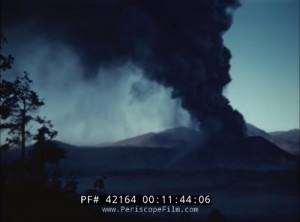
"This extraordinary silent 16mm home movie was shot by Dr. Harold L. Thompson, and shows the eruption of the Paricutin volcano. It likely dates towards the end of the volcanic eruption in the early 1950s." Periscope Film.
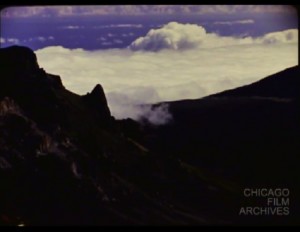
"2 part travelogue film of Hawaii capturing the scenery, resources and people of the islands. Part 1 visits to a lava flow and other natural wonders such as Haleakala Creater and a black sand beach as well as numerous shores and valleys along the way. Stop motion animation of a toy car or ship tracks a change in location. Part 2 features footage of tropical flowers, picking coconuts, family picnic, farming and factory processing pineapple, Hula dance performances, surfing and canoeing competitions, and sunsets."
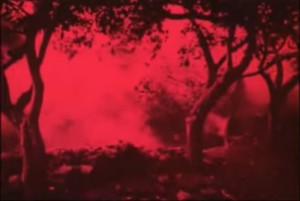
"Footage of the destruction in the Long Beach area after the Long Beach Earthquake, March 10, 1933. Also discusses two theories on what causes earthquakes." Archive.org
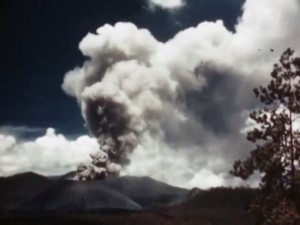
"Paracutin, by Ralph E. Gray, is probably the most complete and accurate record of Mexico's new world wonder yet to be produced on 16mm. film, even possibly in the 35mm. medium. Mr. Gray, long one of Mexico's most devoted American friends, was on the scene soon after the eruption broke out in a peasant's cornfield, and he has made four further trips to record changes and progress in the volcano's life. His superbly filmed footage presents the dramatic subject from every available viewpoint — even to seemingly dangerous closeups of the fiery rim — but it has been edited and is presented in strictly accurate chronological order. Human interest scenes of the effect of the giant cauldron on native life are plentiful and appealing, even to a striking sequence of the heavy dust deposits along the streets of Uruapan, more than thirty miles from the eruption. Paracutin is today a dramatic study of beauty and power; it should prove in the future to be a unique and valuable scientific record." Movie Makers, Dec. 1943, 474.
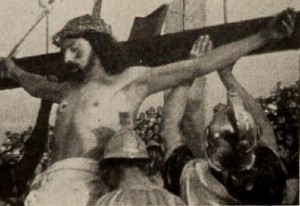
"It is a platitude that there is more in Mexico than meets the eye. In Quaint Old Mexico, however, Guy Nelli proves that there is far more in Mexico than usually meets the camera. Mr. Nelli presents the gradual awakening of Mexico, as the farmers drive their produce to market, with a startling sense of early morning atmosphere; market scenes are developed lucidly and effectively. The high peak of the film is reached with a most remarkable sequence of religious festival shots, as virtually an entire village re-enacts the Stations of the Cross. The intense religious emotion evident in these scenes has rarely been caught for the screen. Mr. Nelli's film is outstanding for its fresh approach and, above all, for the natural and casual quality of its shots." Movie Makers, Dec. 1946, 488.
"Item is a film production of a trip from Naples to Nice taken by Dr. Willinsky and his wife, Sadie. In the form of a travelogue, footage of landmarks, ancient ruins and the local population is interspersed with captions and maps that were added in by Dr. Willinsky to denote locations and offer context. Featured cities include, Pompeii, Salerno, Rome, Cannes, Antibes, and Menton. Footage includes shots of Vesuvius, images taken from a gondala ride in Venice, Venetian street performers, market scenes, cathedrals, children dressed in costumes for a carnival, and various local craftsmen at work. Sadie is occassionally spotted in the footage interacting with locals and with travel companions who are probably relatives or family friends." Ontario Jewish Archives.
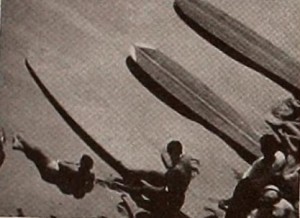
"Dan Billman, jr., has told you in the September number of this magazine how he came to make South of Honolulu. What he could not possibly put into words is the outright and amazing entertainment value of this elaborate record. Hawaii, for the Billmans, meant far more than the Aloha Tower, Diamond Head and the Kodachrome set piece of weekly hula dancing. In their place this adventurous couple found — some 200 miles south of Honolulu — the calm beauty of native life, the exciting patterns of native fishing and feasting and the exotic loveliness of tropical blooms against their true backgrounds. For them, no filming task seemed impossible. Their achievements range from an amusing sequence of the "'sea going" cowboys of the Hawaiian coast, to a striking and incredible study of religious ceremonies within a Buddhist temple. Mr. Billman's beautifully filmed production, accompanied throughout with sound and music personally recorded in the Islands, has the full bodied stature of mature screen entertainment." Movie Makers, Dec. 1941, 564.
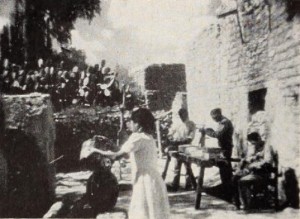
"The vivid pageantry and somnolent landscapes of Mexico assume a new grandeur as filmed by Ralph E. Gray, a cinematographer who has long been recognized as one of the most accomplished amateurs on the continent. The land of contrasts and contradictions is beautifully presented in Typical Times in the Tropics, for here is one of the few travel films that ignore the tourist penchant for flashy trivia, to reveal the spirit of a people and the pictorial splendor in terms of lasting values. Mr. Gray has lived in Mexico long enough to recognize what is really significant; consequently, his film — for all its 1400 feet — seems to be a distillation of the unique charm which continues to attract Americans on vacation. The Mexican's strange blend of religious sincerity and garish ceremony is evidenced in a ritual filmed in Cholula, in which the local livestock — besmeared with gaudy paints and dyes — are presented for the blessing of the village priest — to insure the animals' fertility. The bouganvillea and hibiscus that frame the vistas of sleepy Fortin are contrasted with a boisterous Cuernavaca carnival and the hard riding charros of Mexico City. The latter scenes give Mr. Gray an opportunity to display his technical prowess at its best, for his handling of exposure problems in filming sombrero shadowed faces, his revealing closeups of spectators and skillful following of the wild horses and steer roping are proof of his stature as one of our finest amateur filmers. One of Mr. Gray's most valuable assets is a keen eye for detail, whether it be in the embroidery of a shawl or the weird sculpture left in the path of a lava flow. Intelligent use of a polarizing filter heightens the tawny stuccos of the cathedrals and intensifies the architectural detail of the facades and bell towers; and a fine feeling for human interest gives his shots of a Tehuantepec celebration, the Tirada de Frutas, an added opulence. The cliff divers of Acapulco staged some hairbreadth scenes for Mr. Gray, and he has made the sequence even more breathtaking by cutting in shots of the rocky hazards which had to be cleared by these young daredevils. Saving his trump for a fiery finale, this second time Maxim Award winner winds up with a series of frames of Paricutin, smouldering under her own gray vapors. Sustaining interest throughout 1400 feet of film is no mean task, even when abetted by the natural resources of Mexico; but Mr. Gray has met his challenge with a maximum of taste, discrimination and a completely craftsmanlike approach to a subject that has seldom been presented with such polish and vitality." Movie Makers, Dec. 1946, 470-471.